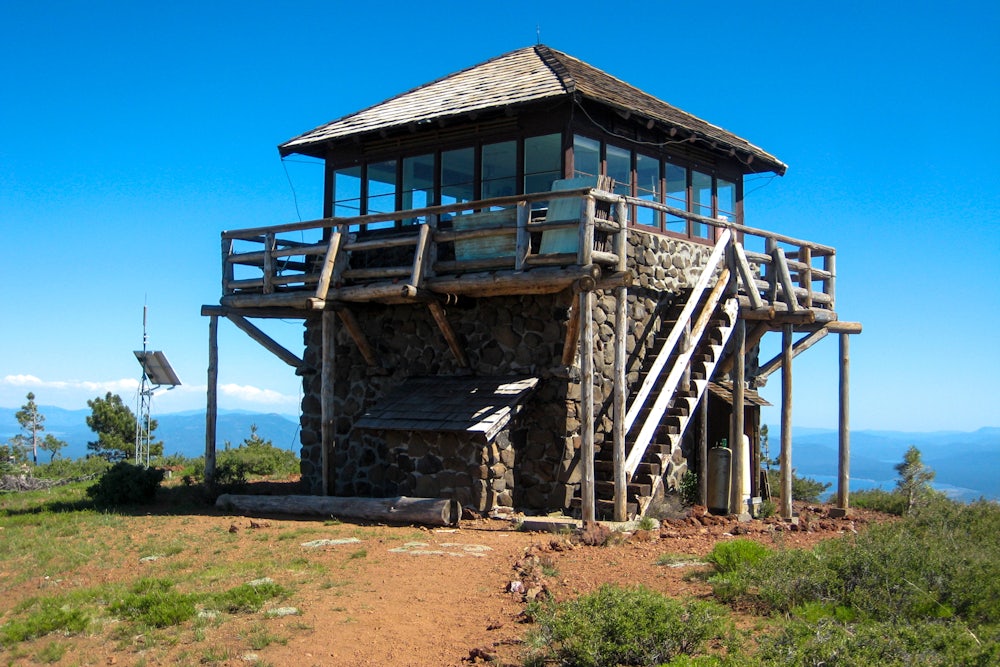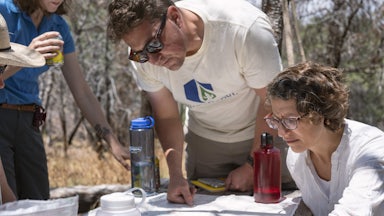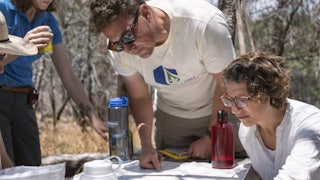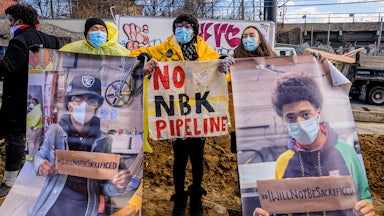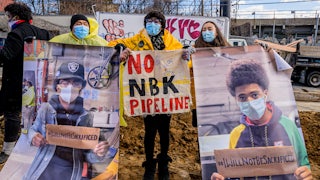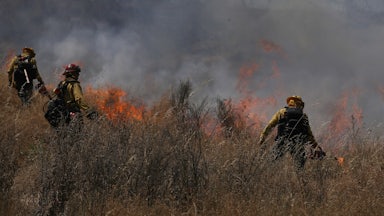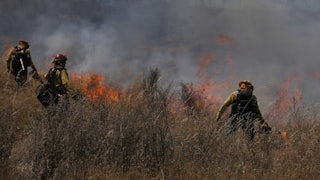“Nobody thought Harkness would go,” Ash Phillips told me plainly. The Mount Harkness Fire Lookout tower was, after all, built atop a sparsely vegetated peak of an ancient cinder cone volcano—not exactly an inviting location for blazes. In 2019, Phillips, serving as an historical architect for the National Park Service, spearheaded its restoration project in California’s Lassen Volcanic National Park. The historic two-story structure built in 1931 holds a couple claims to fame in the niche world of fire lookout culture—it is where Edward Abbey completed his self-described “frankly antisocial” memoir, Desert Solitaire. But after 90 years in the great outdoors, the tower was showing signs of decay. So a team of dedicated volunteers painstakingly returned it to its former glory, hiking each morning up the steep peak and using cured wood from local downed trees, airlifted via helicopter, to match the original building materials.
Only two years after the labor of love was completed, the icon of fire lookout construction was incinerated in California’s single-largest wildfire to date. The Dixie Fire, which burned nearly one million acres, left the trees surrounding the structure intact but reduced the tower to a pile of ashes. “It was just insane,” Phillips said, comparing the fire’s approach to that of a blowtorch.
Despite the fact that wildfire has become an unavoidable presence in many of our lives, fire lookout towers are slipping away. Many of these towers were built during the New Deal Era as part of the Works Progress Administration, which means that they are all nearing a century’s worth of wear and tear. But there’s little political or institutional will to invest in their renewal, given technological advancements in fire detection in recent decades. The work of fire surveillance has gone the way of most everything—increasingly automated. In Biden’s Bipartisan Infrastructure Law, for instance, $20 million in funding is allocated for satellites meant to detect wildfires, and $10 million is for “real-time monitoring equipment” like sensors and cameras.
Historical fire lookouts have two purposes these days. On the one hand, those who choose to spend extended time up in these towers in remote wilderness are tasked with scanning the horizon looking for smoke and helping coordinate firefighting efforts. They also, importantly, are emissaries of the park, interacting with visitors who hike up to their stations. Some of the lookouts are equipped with an Osborne Fire Finder—a mechanical sighting device that allows the lookouts to pinpoint the approximate coordinates of a wildfire without using any electricity. When I stumbled upon Mount Harkness on a weeklong backpacking trip back in 2015, the lookout showed me how to use it, while pointing out the various different mountain ranges visible from the summit.
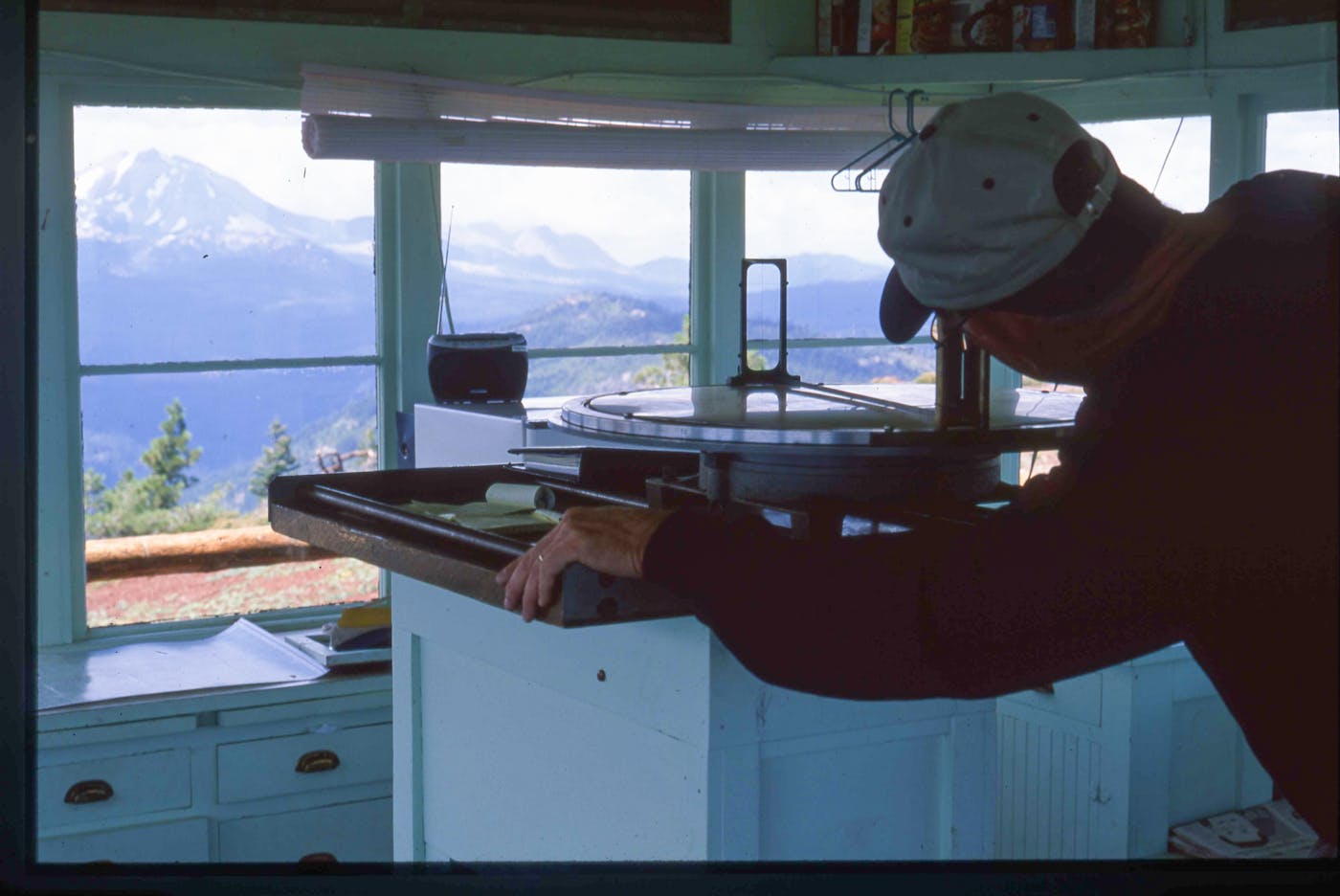
Many of those who work in fire lookout towers are vigorous advocates of what they see as a dying yet irreplaceable service. Kyle Stetler, the State Historic Preservation Office liaison for the nonprofit group Forest Fire Lookout Association, defended the continued existence of lookouts. “The cameras serve one purpose and one purpose only,” Stetler said. “And they don’t give some of those other benefits that a lot of remote lookouts have.” The existential threat facing lookout work is nothing new. “Basically, after World War II, the agency was already moving pretty heavily into aerial fire detection,” said Stetler. “Lookouts have been fighting the battle against the quote-unquote newer technology for a long time.” Aside from the constant vigilance staffed lookouts provide, there is a romance to the work itself. The poet Gary Snyder worked in a lookout tower, as did the writer Jack Kerouac. Stetler’s own grandparents, then young newlyweds, spent three summer months in a lookout tower in Missoula, Montana.
Stetler does acknowledge, though, that the work could be more dangerous now that the fires are becoming so unpredictable, with internal weather systems of their own. As a function of their work, fire lookout staffers are often left alone in remote wilderness areas. When I looked at the Facebook page for Stetler’s organization, among the posts was one member informing the others that a fire lookout tower was rumored to be evacuated and at risk of burning, in the early spring wildfires in New Mexico. “I used to calmly watch for smoke but it’s now changed into a job where I try to look all the time, not even allowing time for a few breaks,” wrote another commenter. “I am afraid, with this drought, of looking away for just a minute and turning around to something awful. The days of a relaxing job are over also, it’s constantly being aware!!”
Yet the same could be said of daily life outside the fire towers in some wilderness areas. This July brought with it the news that a 73-year-old beloved fire lookout named Kathy Shoopman perished in her home as the result of the McKinney fire. Shoopman first began her career watching for fires nearly 50 years ago and was well known in the lookout community. The wildfire obliterated the small Northern California town near the Klamath River where Shoopman lived, and killed four people.
The lookout towers themselves symbolize decades of concerted fire suppression, and in particular the Forest Service’s hard-line stance against wildfires, especially after the great conflagration in 1910, when wildfires burned more than three million acres and killed 86 people, mostly firefighters. Many Indigenous communities who have lived across the West for centuries understood and continue to understand fire as a necessary and healthy force in the ecosystem; European settlers’ priorities were different—they wanted to protect the lumber supply and grazing plains, for one. Now states like California find themselves in an impossible situation. Years of insisting on total fire suppression have created a huge backlog of potential fuel, things like dead trees and brush. Meanwhile, people have built their homes in areas practically guaranteed to burn, given the droughts and extreme weather that global warming is driving.
These lookout towers arguably represent a militaristic approach toward fire in all of its various forms, and an imperialistic approach toward nature. But since their original construction, they’ve become public sites of stewardship where visitors from all over can investigate their own relationship to a constructed notion of wilderness and our ever-changing relationship to these monstrous blazes. “There is a huge loss of interpretation and culture, with not just the loss of the physical structure but that loss of a staffed fire lookout on public land,” said Ash Phillips. Maybe we do need more commonplace interpreters of fire to help us understand the cultural forces, the genocidal violence, the environmental catastrophes, the political motivators, that have shaped our understanding of fire and its forging of the West.
“I don’t want to fight fire,” said Rod Mendes, fire chief for the Yurok Tribe Fire Department. “I want to use fire.” Mendes has been fighting fires in California for 53 years—for cities in the Bay Area, for the Forest Service, for the Marines. When we spoke, he had just returned from 14 days battling the Willow Creek fire, caused by a recent lightning strike.* Over Zoom, he attempted to show me the smoke that was drifting outside his office window. For decades, he adopted the stalwart stance of the various institutions he worked for: When fires appeared, he put them out.
But over the course of his career, as the fires worsened, he began to question the way things were done. Memories began to surface from his childhood. Mendes grew up in a small Northern California town called Orleans, in Humboldt County. His mother’s side of the family is part of the Karuk Tribe. “When I was a kid, my grandmother used to walk around the yard, burning little piles of leaves everywhere,” Mendes recalled. “She had this long stick that had a fork on the end of it. It was a twig. She’d start flicking these leaves everywhere that were on fire. She’d get the whole hillside burning. And it would just burn down to the dirt road behind her house.” There were no ticks in the fields surrounding their homes, he explained. No scorpions or rattlesnakes, though they were plentiful in the area. Their dogs didn’t have fleas. His grandmother understood how to use fire as a way to maintain the landscape.
Indigenous communities across California haven’t just been discouraged from practicing intentional fire use—they’ve been criminalized for it. “Ten, 15 years ago, we would’ve went to jail for that,” explained Mendes. “You can’t have fires. And we still kind of struggle with that, where we have agencies that want to come onto reservation lands and suppress fires without consultation with the [Yurok] Tribe.” Historically, lumber has been a huge source of industry in Humboldt County. “A lot of the fire suppression was to protect the timber supply,” said Mendes. Instead of eliminating sources of fuel around people’s homes, private landowners planted invasive conifer trees to harvest the timber. Still today, if tribal members want to do a prescribed burn, depending on where it is, they might have to ask for permission from the state or the Bureau of Indian Affairs, a federal agency that could take six months to respond, Mendes said.
Those involved in fighting fires are catching on to what Mendes, his grandmother, and members of the Yurok and Karuk Tribes have always known. You can’t eliminate fire from the landscape entirely. “When we talk about facilitating community wildfire preparedness and resilience and adaptation to wildfire by supporting and promoting things like Fire Safe Councils and Firewise communities, that’s not new to Native people,” said Mendes. “They did that already.” Nonprofit groups like the Cultural Fire Management Council are working toward facilitating cultural burns by helping other members of the Yurok Tribe prepare their land for burning, cooperative burning, and training outside fire practitioners through demonstrations. It’s Mendes’s hope that more people across the state will learn not to be afraid of fire and to understand it as a tool necessary for mitigating the current wildfire crisis. But the general public will only feel more at ease with the practice of prescribed burning if it’s something they can see and understand—and if the people who’ve been practicing it safely and effectively for centuries are allowed to do it. “The Yurok reservation and all these reservations suffered because the people that were here knew they needed to burn around their homes, and they knew they needed to burn their prairies off,” said Mendes. “And every time they attempted to, they got arrested. And now they’re coming to us going, ‘How do you do that?’”
Though Mendes is deeply skeptical of the way we’ve fought fires for the past 100 years, he is an advocate for fire lookout towers. Partly this comes from his experience of firefighting. “There is nothing that is more hands-on … than an actual living human being, watching a fire, giving you a size-up, telling you what the smoke is doing,” he said. He still thinks they’re useful, despite all the cameras. But there’s another reason he loves them: As a young child, he spent three pivotal summers living in a fire lookout tower in Orleans. He hiked the 16 miles to the tower for the first time when he was 10 years old, sent by his mother to assist his uncle who was stationed there. His uncle had polio—one of his legs was shorter than the other—and at times had difficulty moving up and down the stairs. Mendes was there to grab food from the cellar, or jugs of water, or occasionally, when his uncle had shot a deer from the tower, to clean its carcass and drag it back up. He can still remember the singular view from up on that mountain. He recently took his son up there on a hunting trip and was so distressed by the deteriorating condition of the tower that he contacted a member of the Forest Fire Lookout Association in hopes of getting it restored.
Ash Phillips, the historical architect who oversaw the restoration of Mount Harkness, considered the fire in Lassen to be ultimately beneficial for the land itself. “There were pockets that were really hot and devastating,” said Phillips, “but it was a good fire. I think the forests were better for it, which is great.” In the wake of the widespread devastation and ecological havoc the Dixie fire caused, this small building is most likely the least of the park’s concerns. And the truth is, even if they wanted to rebuild Mount Harkness Fire Lookout as it once was, they can’t. There were never any measured drawings of the structure, said Phillips. Someone was planning on doing them, but then it burned down.
When the fire reached Mount Harkness, Phillips was no longer living in California. She’d left in large part because of the constant fires: “Unbreathable air is a very valid concern,” she remarked dryly. And then there was the constant threat of evacuation. “Everybody I knew had their car packed with all their worldly goods all summer.” Phillips began having trouble sleeping. One night she woke up and the fire alarms were going off in her house. She thought: Well, this is it, it’s time to run. She grabbed her dog and the go bag that she religiously kept next to her bed. She dashed to her driveway, only to find no fire at her doorstep. It was just so densely smoky outside it had triggered the alarms. She stood there and cried.
When she got into historical architectural preservation, Phillips didn’t know that many of the structures she and her NPS colleagues were painstakingly working to restore would later be wiped out by these catastrophic fires. It’s not just Mount Harkness; last summer in a fire in Rocky Mountain Park, in Colorado, 23 historical structures were destroyed. Phillips now lives in Atlanta, where she works as a historical architect at Martin Luther King Jr. National Historic Park. It spans not acres and acres of wilderness but several buildings across the city that speak to the legacy of the indomitable civil rights leader. She is moved by the mission of the park, the history she is working to preserve. But she also sleeps easier in Georgia than she did in the arid California summers, where the threat of fire was omnipresent. At the end of our conversation, I asked her if she missed being in the outdoors. Phillips smiled. “Every day,” she said.
* This article originally misstated which fire Mendes had been fighting.
